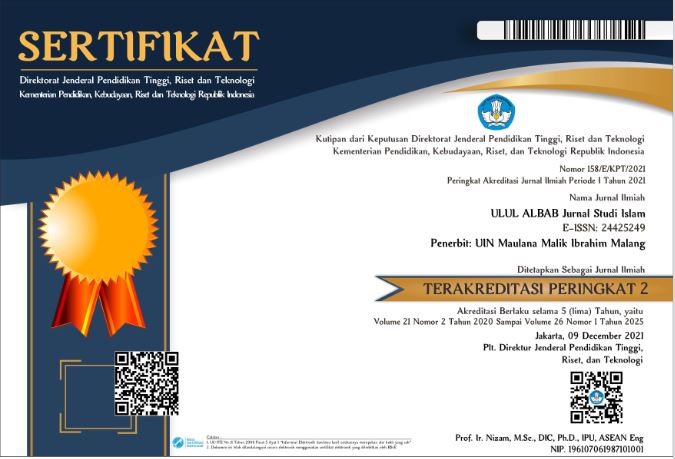THE PARADIGM OF MATN HADITH CRITICISM AND ITS TRANSFORMATION IN THE MODERN ERA
Abstract
Hadiths or Prophetic traditions as primary sources after Quran in Islamic teachings are important to examine and criticize in terms of authenticity and contents. This research aims at discovering the paradigm of matn hadith criticism used by hadith scholars by looking at their methodology. It is also an attempt to answer some Orientalist opinions about classical hadith scholars who only focus on the criticism of sanad and ignore the matn criticism. Through the inductive method, it can be said that the paradigm believed by hadith scholars in matn critique is the law of contradiction where it is impossible for two authentic hadiths to oppose each other as well as it is impossible for sahih and daif hadiths to be different (ikhtilâf). Then this research also tries to discover the form of transformation of the matn hadith criticism in the modern era and that Islamic values are still very relevant in all places and times. This research also shows that there are two forms of transformation, namely internal and external transformation, both of which are driven and influenced by the development and progress of the modern era.
Keywords
Full Text:
PDF (ARABIC)References
al-Adlabî, Shalâḥ al-Dîn ibn Aḥmad. 1983. Manhaj Naqd al-Matn ‘inda ‘Ulamâ’ al-Ḥadîth al-Nabawî. Beirut: Dâr al-Afâq al-Jadîd.
Amrullah, Amrullah. 2016. “Eksistensi Kritik Matan Masa Awal: Membaca Temuan dan Kontribusi Jonathan Brown.” Kontemplasi: Jurnal Ilmu-Ilmu Ushuluddin 4(1): 1–26. DOI: http://dx.doi.org/10.21274/kontem.2016.4.1.1-26
Ayub, Ayub. 2018. “Matn Criticism and Its Role in the Evaluation of Hadith Authenticity.” IJISH: International Journal of Islamic Studies and Humanities 1(1): 69–75. DOI: https://doi.org/10.26555/ijish.v1i1.136
al-Baghdâdî, Abû Bakr Aḥmad ibn ‘Alî ibn Thâbit al-Khaṭîb. 2012. al-Kifâyah fî ‘Ilm al-Riwâyah. Beirut: Dâr al-Kutub al-‘Ilmiyah.
Brown, Jonathan A.C. 2008. “How We Know Early Hadith Critics Did Matn Criticism and Why It’s so Hard to Find.” Islamic Law and Society 15(2): 143–84. DOI: https://doi.org/10.1163/156851908X290574
Brown, Jonathan A.C. 2012. “The Rules of Matn Criticism: There Are No Rules.” Islamic Law and Society 19(4): 356–96. DOI: https://doi.org/10.1163/156851912X639923
Ellyawati, Hetty Catur. 2016. “Analisis Wacana Kritis Teks Berita Kasus Terbongkarnya Perlakuan Terhadap Terpidana Suap Arthalyta Suryani Pada Media Online.” Jurnal The Messenger 3(2): 19–35. DOI: http://dx.doi.org/10.26623/themessenger.v3i2.267
Fairclough, Norman. 1992. “Discourse and Text: Linguistic and Intertextual Analysis within Discourse Analysis.” Discourse & Society Journal 3(2): 193–217. DOI: https://doi.org/10.1177/0957926592003002004
Ismail, M. Syuhudi. 2016. Metodologi Penelitian Hadis Nabi. Jakarta: Bulan Bintang.
‘Itr, Nûr al-Dîn. 1979. Manhaj al-Naqd fî ‘Ulûm al-Ḥadîth. Damascus: Dâr al-Fikr.
al-Jawâbî, Muḥammad Ṭâhir. 1991. Juhûd al-Muḥaddithîn fî Naqd Matn al-Ḥadîth al-Nabawî al-Sharîf. Tunisia: Mu’assasât Karîm ibn ‘Abd Allâh.
Kamba, Muhammad Nursamad. 2020. Accessed March 6, 2020 15:38 WIB. https://twitter.com/mnkamba/status/1227604283006210049?s=08
Karcic, Fikret. 2006. “Textual Analysis in Islamic Studies: A Short Historical and Comparative Survey.” Islamic Studies 45(2): 191–220.
Khalaf, Najm ‘Abd al-Raḥmân. 1989. Naqd al-Matn bayna Ṣinâ‘at al-Muḥaddithîn wa Maṭâ‘in al-Mustashriqîn. Riyad: Maktabah al-Rushd.
Muhsin, Masrukhin. 2017. “Kritik Matan Hadis Studi Komparatif antara Sarjana Muslim dan Sarjana Barat.” AlQalam: Jurnal Kajian Keislaman 34(1): 167–202. DOI: http://dx.doi.org/10.32678/alqalam.v34i1.1946
Mujibatun, Siti. 2014. “Paradigma Ulama Dalam Menentukan Kualitas Hadis dan Implikasinya Dalam Kehidupan Umat Islam.” Analisis: Jurnal Studi Keislaman 14(1): 201–38. DOI: https://doi.org/10.24042/ajsk.v14i1.655
Munfarida, Elya. 2014. “Analisis Wacana Kritis Dalam Perspektif Norman Fairclough.” Komunika: Jurnal Dakwah dan Komunikasi 8(1): 1–19. DOI: https://doi.org/10.24090/KOMUNIKA.V8I1.746
al-Nawawî, Muḥy al-Dîn Abû Zakariyâ. 2001. Ṣaḥîḥ Muslim bi Sharḥ al-Nawawî. Cairo: Dâr al-Ḥadîth
Noverino, Romel. 2015. “Kajian Analisis Wacana Kritis Intertekstualitas (Interdiskursivitas) Pada Terjemahan yang Menggunakan Bahasa Gaul.” Proceeding PESAT (Psikologi, Ekonomi, Sastra, Arsitektur & Teknik Sipil): Jurnal Universitas Gunadarma 6: 108–16.
al-Ṣalâḥ, Abû Amr ibn. 1986. ‘Ulûm al-Ḥadîth. Damascus: Dâr al-Fikr.
Suryadi, Suryadi. 2015. “Rekonstruksi Kritik Sanad dan Matan dalam Studi Hadis.” Esensia: Jurnal Ilmu-Ilmu Ushuluddin 16(2): 177–86. DOI: https://doi.org/10.14421/esensia.v16i2.996
al-Suyûṭî, Jalâl al-Dîn ‘Abd al-Raḥmân ibn Abû Bakr. 1988. Tadrîb al-Râwî fî Sharḥ Taqrîb al-Nawawî. Beirut: Dâr al-Fikr.
al-Ṭaḥḥân, Maḥmûd. 1996. Taysir Muṣṭalaḥ al-Ḥadîth. Riyad: Maktabah al-Ma‘ârif.
Tangngareng, Tasmin. 2016. “Methodology of Hadith Content Criticism: A Study of the Thought of Salah al-Din bin Ahmad al-Adlabi”, Esensia: Jurnal Ilmu-Ilmu Ushuluddin 17(1): 97–110. DOI: https://doi.org/10.14421/esensia.v17i1.1281
DOI: https://doi.org/10.18860/ua.v21i1.8936
Refbacks
- There are currently no refbacks.
Tools:




Indexed By:








All publication by Ulul Albab: Jurnal Studi Islam are licensed under a Creative Commons Attribution-ShareAlike (CC BY-SA)
Ulul Albab: Jurnal Studi Islam, P-ISSN : 1858-4349, E-ISSN : 2442-5249



